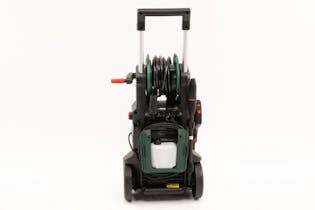6 things we learned while testing waterblasters
If you’ve got a green patch of grime to blast clean before summer arrives, you might be thinking about buying a new waterblaster. Or maybe you’ve been watching those super satisfying TikTok videos of people turning dark stained paths light and bright again and fancy attempting it yourself.
We tested 16 waterblasters and thought we’d share a few things we learned as we put each through its paces on dirty and mossy concrete paths.

1. They don’t waste water
You might think you’re blasting through a lot of water as you spray away grime to your heart’s content, but actually you’re not. An average garden hose on high uses about 30 litres per minute, but the waterblasters we tested had flow rates of about 5-7 litres per minute.
2. The box won’t tell you if it’s actually any good
If you want those sweet clean lines without having to go back and forth, you might think it makes sense to compare models on their maximum water pressure – shown as psi. Yet we found flow rates – L/min – are a better gauge of performance. Our top scoring model had the highest flow rate while the lowest scorer had the lowest flow rate.
Even then, there are models that don’t have particularly high pressure or flow rates that have become some of our favourites. The best way to know if you’re getting the best is to check our test results. We time how long it takes to clean a stained concrete path and assess how easy the blasters are to use.
3. Don’t get sucked in by big bundle packs
It’d be easy to walk into a hardware store to buy one of these things, and walk out more than $1000 poorer, having been convinced you need one with all the bells and whistles – like deck and car cleaning attachments. We reckon just start with a good base kit and you can add the accessories you really need later.
4. You want one with a metal pump
The pump on your waterblaster is responsible for putting the water under enormous pressure. That’s what makes them clean things so well.
James le Page, our product test team leader, is responsible for our waterblaster testing, and said some models have plastic parts in the pump that may not last the distance.
“A blaster with a plastic pump will perform well for occasional use for shorter sub 20 to 30 minute jobs, but won’t last the distance if you’re using it for extended periods of time,” James said.
“If you intend to tackle big jobs, choose one with a metal pump. Be sure to ask if your chosen model has plastic parts in the pump. As a rule of thumb, I say that if it’s cheap, it will probably be full of plastic.”
5. ‘Pressure washer’ doesn’t mean it’s not as good as a waterblaster
You might think a product marketed as a pressure washer isn’t going to be as powerful as a waterblaster, but James says that’s just jargon. In Australia, they’re more likely to be called pressure cleaners or pressure washers, while here we usually call them waterblasters.
6. You don’t have to spend a lot
If you’re weighing up whether to get someone to do the job for you, you might be surprised how cheap a good blaster can be. Without giving away too much, we’ll say there’s one we recommend that costs less than $150 at Bunnings.
See our waterblaster test results to find out:
- the brand of waterblasters we think is the best
- the expensive model we rated second to last
- whether the cheapest model we tested – priced at $125 – is any good.
Our waterblaster buying guide also includes tips for using your new waterblaster, plus advice on the nozzles and attachments they can come with.
We've tested 19 waterblasters.
Find the right one for you.
Bosch

Bosch
.jpg&w=315&q=75)
Bosch
.jpg&w=315&q=75)

Member comments
Get access to comment